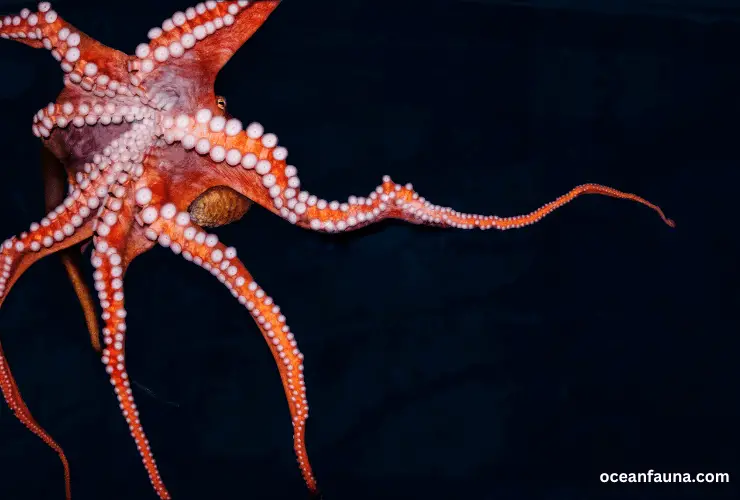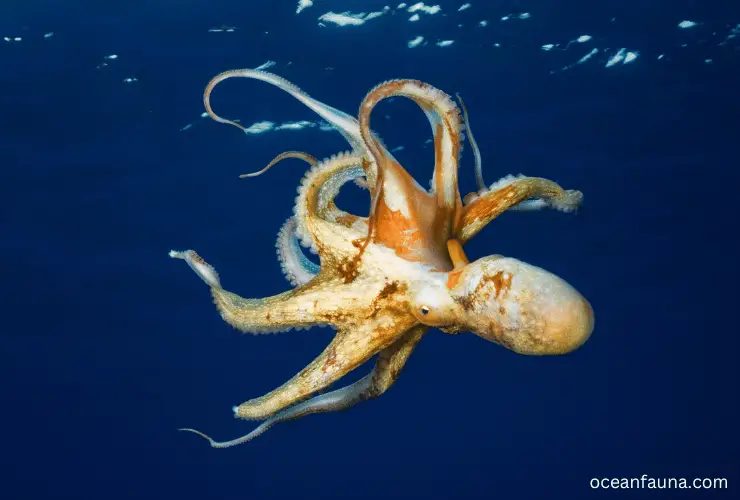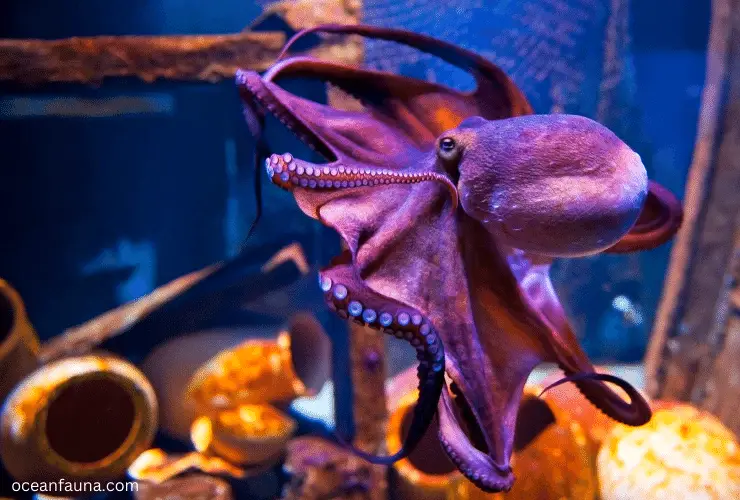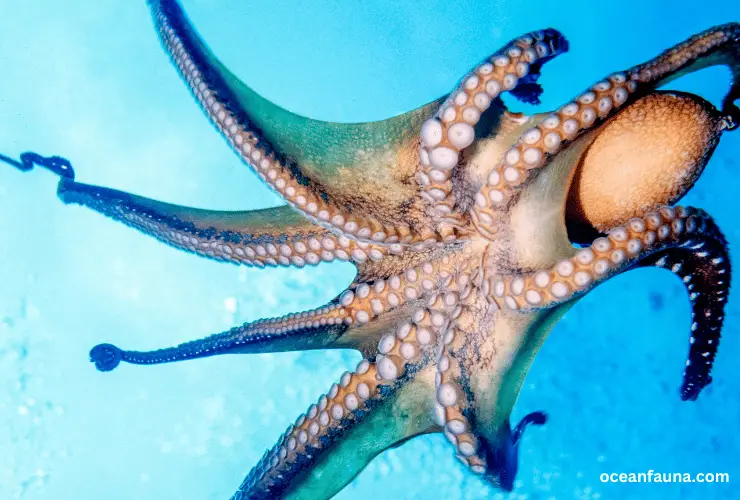Yes, Octopuses can regrow their limbs or arms. As octopuses live in the wild environment, they might lose limbs during hunting or being attacked by any predator. Sometimes they even deliberately lose their limbs which we’ll find later in this article.
But fortunately, they can regenerate their limbs. Basically, after getting injured, the wound started tightening and reducing its size. Then the rigorous process of healing starts. And this process lasts 130 to 150 days. They can regenerate arms as well as the previous one.
Though octopuses have eight limbs, losing one or two limbs makes their life quite difficult. So as soon as they regrow their limbs back, they can go back to hunting and swimming like normal time.
Until now, I’m sure you got very curious to know how the whole process works and every detail regarding this. No worries, we’ll unfold everything about regenerating octopus limbs in this article.
So, let’s get started.
How Many Limbs Do Octopuses Have?
Before understanding whether an octopus can regrow its limbs, let’s find out how many arms an octopus has.
Basically, octopuses have eight limbs. But to be specific, an octopus has six arms and two legs.
Primarily, the name octopus refers to two different ancient greek words. One is ‘octo,’ meaning eight, and ‘pus,’ meaning feet. But the octopus’s limbs are not completely multipurpose.
That’s why octopus limbs are divided into two categories. Now let’s see what the functions of arms and legs are!
Arms
An octopus has three pairs of arms. These arms are used to grab food, swim, and propel. However, the amazing fact is that an octopus can use every pair of arms simultaneously. But octopuses prefer to catch the prey with the three arms at the front.

The males have only one arm, which is called a hectocotylus. It’s responsible for the transmission of spermatophores to the female reproductive tract. While mating, the male can either use it normally, like in other animals. But he can remove it if needed. This is known as autotomy.
Legs
Octopuses have only one pair of legs. These legs are situated at the back of an octopus. However, octopuses do not use their legs as often as their arms.
Mainly, legs are most used while an octopus needs to crawl, maneuver or push off the seafloor.
How Do Octopus Limbs Appear to Be?
Octopus arms are long muscular strings starting at the bottom of their head. But if you look closely at the strings, you’ll notice that these strings are wide at the base and narrow at the tip.
Moreover, these limbs are covered with suckers that help an octopus catch prey. As octopuses are invertebrates, they have no bones in their limbs.
But in some species, like umbrella octopus, you’ll find webbings between the arms. And at the base of the arms are an octopus’s beaks or teeth.
Why Does an Octopus Lose Its Limbs?
As you already know that octopuses can grow back their limbs. But now the question is why they lose their limbs.
Well, they might lose their arms due to hunting, during reproduction, or by the attack of predators. Or even sometimes, they deliberately lose their arms.
Scientists have found in a survey that 50% of octopuses have lost at least one of their arms. But fortunately, they can regrow their limbs.
Now let’s go into the in-depth discussion of why octopuses lose their limbs.
Reproduction
Losing limbs during mating is a very common practice in octopuses. Basically, male octopuses might lose their specialized leg hectocotylus. This leg is used to transfer sperm to the female octopus.
So they deliberately remove the limbs because it is a natural process. But sometimes female can become aggressive and eats their male partner. And this is another reason why male octopuses detach this particular body part.
Now, female octopuses lose 50% of their body weight after laying eggs. Moreover, Autophagy (consumption of own body parts due to starvation or any diseases) allows the octopus to digest its tissues, although it frequently results in limb loss.
Besides, one of the upsetting facts is that lost arms in reproduction will not grow back. That’s why most octopuses enter into senescence (oldness) after mating. Therefore, male octopuses die after a few weeks of copulating. And the female octopuses will protect their eggs till hatching, and they’ll die too.
Deliberately
Octopuses can detach their own limbs. This is known as arm autotomy. They do it when their arm is trapped in something or damaged somehow.
And sometimes, if any predator attacks them, they deliberately remove their arms. It works as a distraction so that they can escape.
Can Octopuses Regrow Limbs?
Yes, they can. If an octopus somehow loses one of its limbs, it will regrow a completely new limb. This process is called morphallaxis.
This whole process will take around 130 days. And this starts immediately after an octopus gets injured. In most cases, the new arm is as good as the old one.
An octopus arm is an extremely sophisticated organ. The octopus relies on its eight pliable, prehensile arms for all aspects of its existence, including locomotion, feeding, and reproduction.

Arms are so intricate that they contain two-thirds of the octopus’s neurons. And allowing them to perform sophisticated reflex motions independently of the brain. It is commonly believed that each limb contains a miniature brain.
This means that the octopus, in addition to producing new blood vessels, muscles, skin cells, and suckers, regrows a new arm. It is also growing a brand new, highly complex mini-brain neural network. This shows the importance of the regrowth of their limbs.
How Does an Octopus Regrow Its Limbs?
The process of regrowing an octopus’s limbs is quite a complicated task to understand. However, the process includes renewing, growing new cells and tissues, and restoring.
To understand the mechanism, scientists have researched this and found some interesting facts.
To do so, they anesthetized six female octopuses. Then, they removed a few inches from each limb and observed how they regrew their limbs.
Also, they notice three specific stages in this total regeneration process. They are:
- Wound healing
- Regeneration
- Renewal
Importance Of AChE in Regeneration
It’s important to understand the importance of AChE before going into the detailed process of how an octopus regenerates its arms.
First of all, AChE is an enzyme. The full form is acetylcholinesterase plays a key role in the octopus limb or arm regeneration process.
This enzyme basically sends signals from one neurotransmitter to another. So, whenever the brain sends a signal to any muscle, the medium is AChE.
In the research, scientists have noticed that the amount of AChE significantly increases and decreases according to the intensity of the wound and healing. That means an octopus can control the AChE’s flow.
AChE is strongly connected to the nervous system around the injured tissue. This enzyme passes through the system normally till the third week. But, the AChE flow increases when an octopus regenerates limbs and suckers.
And this will continue until the regeneration is completed. Once an octopus successfully regrows its arms, the AChE flow will return to normal.
Another important chemical that helps in the process. This is known as hemocytes.
When an octopus regrows its limbs, they need energy. And that’s where hemocytes come in the game. So as soon as there is a scar on the octopus’s body, the hemocytes rush to the location. Then it’ll clean the damaged tissue and cellular debris.
Scar tissue is a protective barrier, preventing further damage from germs while not interfering with the healing process. It is found that this plug helps produce the primary blastema, which provides materials for the regeneration limb.
Now let’s get into the details of the regeneration process step-by-step here. Also, scientists make sure that germs don’t affect those octopuses.
Initial Few Hours
After a few hours of surgery, the wound size started reducing and tightening. And hemocytes will be immune to the damaged tissue and clean the wound, as previously said.
Day Three
The regeneration or regrow process will start after three days of the surgery. At this time, biochemical flows develop a knob at the point of the injury instead of forming a scab. A layer of epithelium cells covered the knob.
This knob looks more like a hook structure. The main function of the knob is to block the water so it doesn’t interfere with the regeneration.
Now cells called blastema started to form to replace the lost tissue. These stem cells can potentially differentiate into various specialized cell types. For example, skeletal and nervous system components, muscle cells, and even suckers are all vital to the proper function of the human arm.
Day 11 to 17
The new cells continue growing. On top of that, the hook-like structure boost the regrowing process. This knob has become more prominent these days.
Stem cells hidden behind the hook-like form have started to differentiate into the arm’s various tissues. And new blood vessels are actively supplying the regeneration site.
Day 28
After almost 28 days or one month, the knob at the injury started to disappear. With that being said, the temporary blood vessels got the chance to grow into the new arm.
Day 55
Basically, an octopus takes almost a month to heal the wound. And the next month is the time to grow back or restore all the missing components.
After Three Months Or 300 Days
The regenerative process completes after three months. After 100 days, the entire limbs look complete. And the strength of the new arm is as good as the old one.
Why Does an Octopus Regrow Its Limbs?
The eight octopus limbs give so many advantages, including hunting and swimming. In that case, if they lose one of the limbs, it’ll be hard for them to roam around.

However, they still can manage, but it will put them at risk while searching for food. On top of that, they’ll find more difficulties when a predator attacks.
But as they regenerate their limbs, they can return to normal life after some time. And even if it does take a few months, that’s still quite an accomplishment.
Can An Octopus Survive Without Its Limbs or Arm?
From the previous, it is visible that an octopus can survive without an arm. Even in some research, scientists found that losing one or two arms at a time is pretty normal in the octopus world. And they can regrow their arms.
So, if an octopus loses one or two limbs, then another six limbs can support the octopus. Moreover, octopuses are incredibly agile and flexible. They have the manual dexterity to open screw-top jars, peel apart oysters, and can manage the situation around them.
Besides, these arms have their own neuron system that can move without communicating with the central brain.
Therefore, if one arm is lost for whatever cause, the remaining arms perform admirably. This is why an octopus’s legs will continue to move for a while after it has passed away.
How Long Does It Take for An Octopus To Grow Its Limbs?
If an octopus loses one arm, it can grow a new one in full working order in roughly 102 to 132 days.
While it’s true that some animals can regenerate missing limbs, in most cases, the resulting appendage isn’t quite as functional as the original. Regenerated tails in lizards, for instance, are usually not as good as the originals since they are made from immature cells.
But for octopuses, it’s different. They can grow fully functional new arms like the original.
Interestingly, when an octopus loses an arm, it must develop a new mini brain with a network of up to 40 million neurons. Isn’t that fascinating?
FAQs
Do the arms of octopuses have brains?
In a scientific sense, the arms of an octopus indeed have their own brains. Most of an octopus’ neurons (which function as miniature brains) are found in its arms, though it has a central brain. The octopus’s arms can be detached from the body and still function for a long time without losing their sensitivity.
Do tentacles function similarly to arms?
Arms and tentacles are not the same things. There is a common misconception that all cephalopod limbs are tentacles. But in reality, tentacles and arms are two very different limbs. You’ll find suckers run along the majority of the length of the arms. However, in tentacles, the suckers are situated only at the tip.
Could an octopus eat its own arm?
Certainly yes. Octopuses have been known to consume their arms. Many factors contribute to the possibility of an octopus consuming an arm. When octopuses are bored and constrained, they resort to autophagy (eating themselves) to pass the time. In the senescent stage (growing old) of their lives, female octopuses cut off pieces of their arms.
What happens if an octopus arm is cut off?
Each octopus arm has its own neural capacity. That’s why the severed octopus arm will still function even after being disconnected from the main body. The disconnected arm will give automatic responses and move around on its own.
Some researchers have found that the severed arm will try to bring food to the spot where the octopus’s mouth would be.
Conclusion
So, can octopuses regrow limbs? Till now, it has been confirmed that they can regenerate their arms.
Octopuses might lose an arm during reproduction or while protecting themselves from predators. Or if they get trapped, they’ll deliberately remove their limbs.
But their physical structure will help them to grow back their arms. On top of that, like the original limb, the new arm will be fully functional and strong.
Octopus arms are a very important organ for themselves because they act like mini-brain. That’s why they can still function if they get cut off.


1 thought on “Can Octopuses Regrow Limbs?”